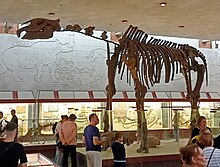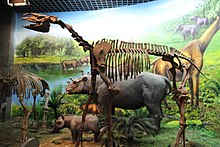

| Paraceratheriidae
| |
|---|---|

| |
| Skeleton of Paraceratherium | |

| |
| Skeleton of Juxia | |
| Scientific classification | |
| Domain: | Eukaryota |
| Kingdom: | Animalia |
| Phylum: | Chordata |
| Class: | Mammalia |
| Order: | Perissodactyla |
| Superfamily: | Rhinocerotoidea |
| Family: | †Paraceratheriidae Osborn, 1923 |
| Subgroups | |
| |
| Synonyms[1] | |
Paraceratheriidae is an extinct family of long-limbed, hornless rhinocerotoids, native to Asia and Eastern Europe[3] that originated in the Eocene epoch and lived until the end of the Oligocene. They represent some of the largest terrestrial mammals to have ever lived.

The necks and limbs of paraceratheriids are elongate relative to those of living rhinoceroses.[4] The earliest paraceratheres like Juxia were comparable in size with living rhinoceroses with a body mass of three quarters to one and a half tons, while later members grew substantially larger, with the largest representatives (Paraceratherium, Dzungariotherium) estimated to have a body mass of 17 to possibly over 20 tonnes, making them the largest land mammals to have ever lived.[5][6] All non-fostercoopine paraceratheriids are united by the possession of a retracted nasal notch, a lack of contact between the premaxilla and nasal bones of the skull, enlarged upper and lower first incisors and small lower canine teeth, along with characters relating to the size and shape of the molars and premolars.[3]

Their range spanned from Eastern Europe in the west, the Indian subcontinent in the south, to Northern China in the east.[3]
Paraceratheriids are thought to have been primarily browsers.[7]
Although considered a subfamily of the family Hyracodontidae by some authors, recent authors treat the paraceratheres as a distinct family, Paraceratheriidae (Wang et al. 2016 recover hyracodonts as more basal than paraceratheres).[8][9] Some authors choose to include the small, primitive fosterocoopines (Forstercooperia, Pappaceras) within the family,[10] while they are excluded by other authors.[3]
| Indricotheriinae |
|
|---|---|